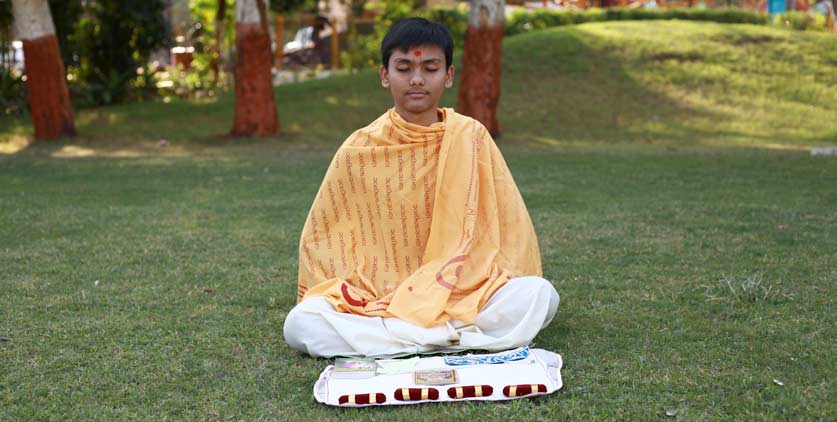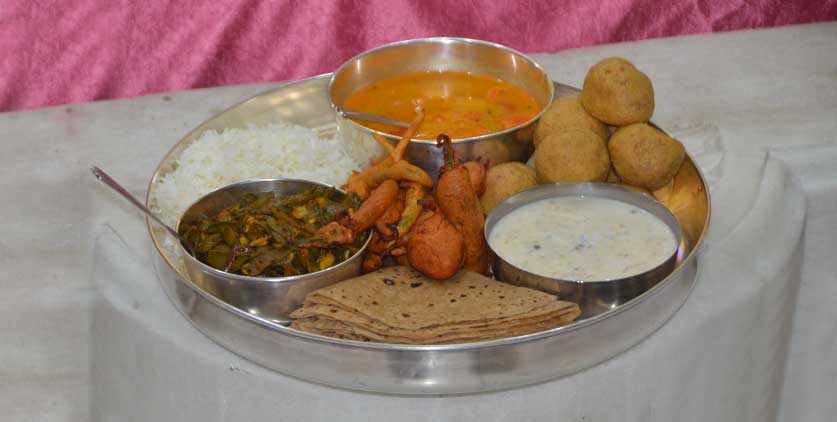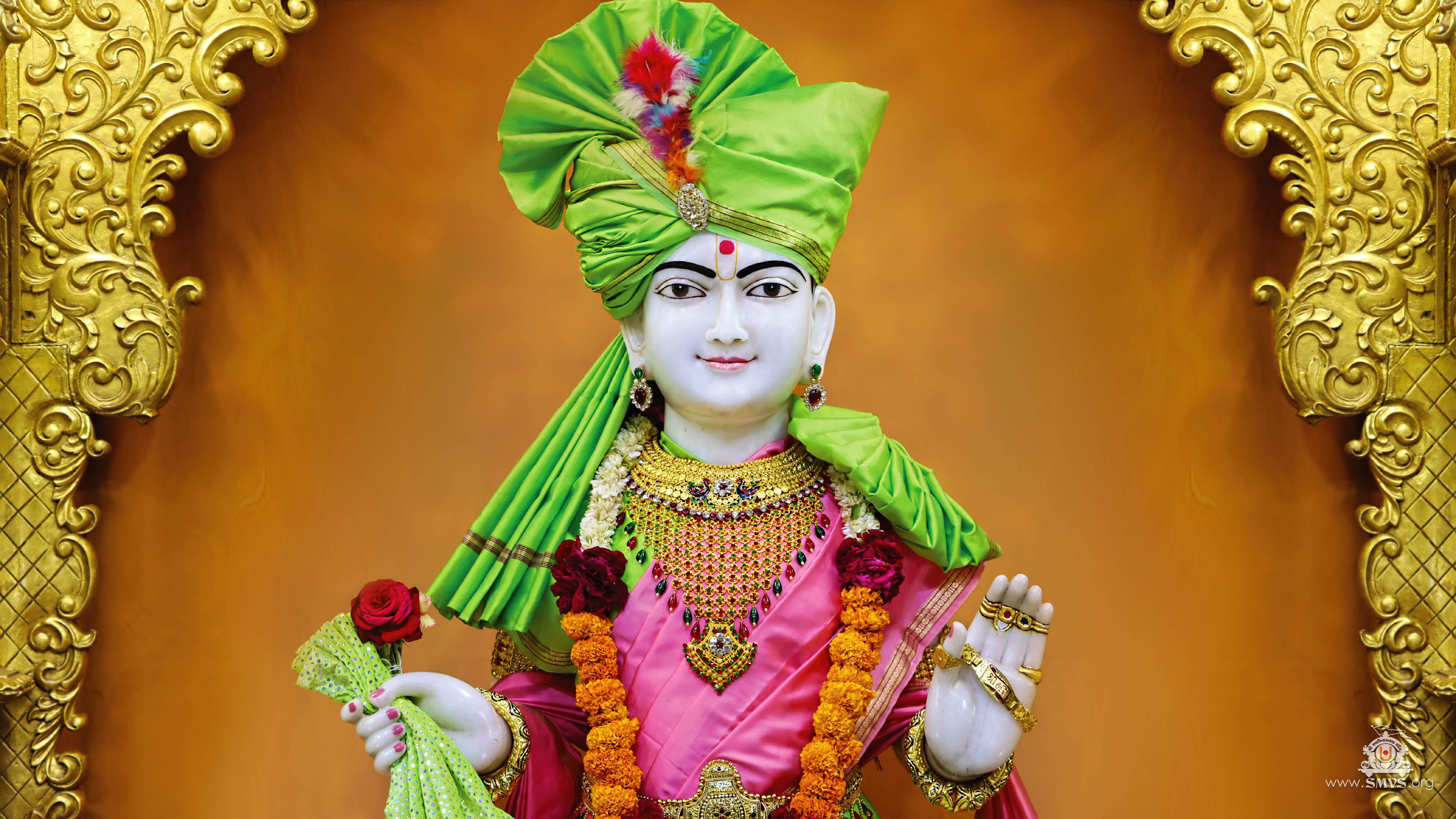
Spiritual Practices
Mansipooja
Even a devotee of Bhagwan experiences inner longings, though distinctly different from those of worldly beings. The devotee yearns not for worldly pleasures but for divine opportunities to lovingly serve the God, the Supreme Beloved. This loving desire expresses itself in:
Awakening Bhagwan with affection
Offering ritual bathing and adorning
Preparing and lovingly serving meals
Beautifying with new decorations and ornaments
Rocking to sleep in divine bliss
These heartfelt urges culminate in the constant pursuit of seva (divine service) and expressing deep love.
Bhagwan's service is practiced in two ways:
1.Physical (Daihik): Through external rituals and offerings to Bhagwan's divine murtis.
2.Mental (Mansik): Through inner contemplation and imagined offerings to one's most beloved form of Bhagwan. That is the Mansipuja.
Mansipuja enables any devotee, regardless of means, to offer the finest service with utmost devotion and creativity.
Shriji Maharaj instructed His followers to perform mansipuja five times daily. For a true devotee of Bhagwan, performing daily mansipuja becomes an essential part of their spiritual discipline. In fact, He guided that the nature of each mansipuja should adapt to the three primary seasons—summer, monsoon, and winter—to reflect the changing moods and needs of Bhagwan accordingly. (Gadhada II-23)
Furthermore, in Vachanamrut Gadhada I-19, Maharaj emphasizes that one should perform mansipuja with deep affection and also serve Bhagwan physically through the nine forms of devotion. Such a combination of inner and outer bhakti ensures that the worship is heartfelt, continuous, and pleasing to Bhagwan.
In relation to whether direct physical worship or mansipuja is superior, Shriji Maharaj clarifies in the Vachanamrut (Sarangpur-3): "If a devotee worships Bhagwan directly or performs mansipuja with such intense love that the body is thrilled with divine emotion and the voice becomes choked with devotion, then both forms of worship are the highest. However, if either form is carried out dryly—without emotional fervor, trembling limbs, or a choked voice—then both are considered deficient."
This establishes that the quality of devotion, not the medium, determines the spiritual merit in Bhagwan's eyes.
Great sants have explained that "dying five times a day" means transcending bodily awareness through intense mansipuja. Even capable and enlightened souls like Bapashri engaged deeply in this practice. Swamis have taught that one must be ready to pause any worldly duty to offer timely mansipuja.
How to Perform Mansipuja According to Bapashri
Bapashri beautifully illustrated the depth of mansipuja through divine examples. Once, Parvatbhai was plowing a field while simultaneously doing mansipuja. During the puja, the rope in his hand fell as though he had physically offered something. That is how real and immersive mansipuja should be—so involved that it feels as tangible as actual service. However, he added, one must not become restless or distracted. Bapashri emphasized, "Perform mansipuja in such a way that if someone were to try to pull Bhagwan out of your envisioned murti, it would not be possible."
He further advised: if someone asks you a mundane question during mansipuja, such as, “Where is the basket of scraps?”, do not break your focus to answer it casually. During mansipuja, until the moment you conclude, your mind must be absorbed fully in the murti without letting external thoughts enter.
(Abajibapashri's vato- 1/206)
Mansipuja is a profound form of devotion driven by love. It is the act of serving Bhagwan through one’s mind. Since the mind is naturally restless, this becomes a powerful practice to tether it to the divine form. Unlike physical seva, which may require costly garments, ornaments, or elaborate meals, mansipuja demands neither wealth nor external effort. Any devotee, whether rich or poor, can offer the highest quality of service with utmost love and emotion. This universality is a testimony to Bhagwan’s infinite grace—He lovingly accepts service performed without expense or show, and bestows divine rajipo upon such sincere efforts.
Bapashri have consistently emphasized regular and punctual mansipuja. Bapashri's words are recorded on many occasions, such as when He visited Kakarvadi. After arriving there, He sat beneath a jamun tree and performed mansipuja with deep concentration. HDH Swamishri would say, "Mansipuja must be done regularly and on time. If you are driving and the time for mansipuja arrives, you should stop the vehicle by applying the brake, come to a halt, and perform mansipuja right there."
As Bapashri advised: “Perform mansipuja five times daily. Even if each session takes half an hour or an hour, it is worthwhile. If two hours pass, then do another mansipuja. In this way, there’s never idleness.”
A beautiful example is of a teacher who, when asked by Swamishri whether he performed all five daily mansipujas, confirmed doing so even while teaching in class. He said, “Due to Gurudev Bapji’s grace, I have mastered such inner focus that I can perform Bhagwan’s mansipuja even while engaged in other duties.” Swamishri responded with joy, saying, “Yes, if one has that level of mastery, it can be done anytime. But only if one has that focus—otherwise, not.”
Bapashri further clarified that instead of imagining worldly objects and pleasures, one should envision offering divine garments, food, and ornaments to Bhagwan. In such divine consciousness, one naturally feels more connected to the murti.
One must pour their entire heart into mansipuja, withholding nothing in Bhagwan’s service. “As is the body, so should be the offering to God”—in other words, offer to Bhagwan all that you personally cherish. When this level of love is involved, the mind settles easily in the murti.
Even a humble shopkeeper, who owned a small stall, was deeply committed to his spiritual routine. No matter how busy the day or how many customers arrived, he would pause everything to perform mansipuja at the designated time.
One morning, as the sun began to rise and his stall opened, it was time for his mansipuja. He envisioned preparing warm milk for Thakorji, just the way Maharaj liked it. In his mental offering, he placed a pot on the stove, poured the milk, and added a fistful of sugar. But just then, a customer arrived and called out, “Seth…!”
Startled yet composed, the shopkeeper gently paused his puja, served the customer, and returned to his mental worship. Picking up where he thought he had left off, he added what he assumed was the first spoon of sugar—but in truth, it was the second. This meant the milk was now overly sweet.
His frugal nature stirred concern. “If Maharaj gets used to such sweet milk,” he thought, “He may expect it every day. That will increase my expenses. How will I manage?” Looking into the mental pot, he noticed the sugar had not yet fully dissolved. So, he resolved to remove the excess.
He reached in—mentally, yet sincerely—to scoop out the sugar. In that very instant, a divine moment occurred: Bhagwan held his hand and stopped him.
“Maharaj!” the shopkeeper exclaimed in his heart. “Let me remove the sugar before it dissolves.”
Bhagwan, smiling with immense love, replied, “, Oh man, I won’t ask for sweet milk everyday. Don’t worry, I won’t get used to it. But right now, I’m holding your hand so it doesn’t get burned. I’m not worried about the milk—I’m worried about you.”
Tears welled in the shopkeeper’s eyes. What began as a mental offering had become a divine darshan. Bhagwan had accepted his bhakti so fully that He appeared in his meditation—not as imagination, but as a real, living presence.
This was no ordinary moment. Bhagwan had transformed a simple act of mansipuja into an extraordinary, direct experience. It was the fruit of sincere, loving devotion—pure mansipuja embraced by the divine Himself.
Parvatbhai, a spiritually awakened and anadimukta devotee, lived in the village of Agatrai in the Saurashtra region. Outwardly, he appeared as a simple Kanbi farmer, dressed plainly and speaking little. But inwardly, he was deeply engrossed in divine consciousness, constantly absorbed in Bhagwan's murti.
One day, Parvatbhai was working in his field. He had yoked oxen to the plough and was directing the tilling with a strong grip on the reins. As the oxen pulled steadily through the field, the time for his afternoon mansipuja arrived.
Rather than stop the physical task, Parvatbhai gently placed the reins down and, while still walking behind the plough, he closed his eyes and entered a divine state of mansipuja. He envisioned Maharaj standing before him. In one hand, he imagined holding a thaal filled with warm bajra rotlo (traditional millet flatbread), freshly roasted over a traditional clay griddle. In the other, he held a small pot of creamy, thick dahi.
So deeply engrossed was he in offering this to Bhagwan that his hands involuntarily moved to present it with loving insistence. As he was mentally feeding Bhagwan, completely immersed in emotion and love, his hands physically reacted—and the real bajra rotlo and dahi he was carrying in preparation for his own lunch slipped from his hands and spilled on the plough and into the soil.
His fellow laborer, startled by this, called out several times to get Parvatbhai’s attention, thinking he was perhaps asleep or dazed. But Parvatbhai remained still, his eyes closed in serene devotion, entirely engaged in feeding Bhagwan. When finally nudged with a stick to awaken him, the rotlo and dahi visibly fell from his hands, shocking the onlooker.
Upon opening his eyes, Parvatbhai calmly explained, “I was feeding Maharaj. You interrupted that service. Maharaj has accepted my mansipuja as actual service today.”
This divine incident became a timeless example of how sincere, emotionally-charged mansipuja can be accepted by Bhagwan just as direct, physical worship. It illustrated the full reality of spiritual vision and Bhagwan’s compassionate presence in the life of a true bhakta.
Another sincere devotee named Sukhram lived in the village of Rampur, near Sunth. He was a Brahmin and a faithful follower of Bhagwan Swaminarayan. One day, Sukhram traveled to Ahmedabad to sell some gold ornaments. Unfortunately, he did not receive a satisfactory price for them, so he decided to take the ornaments back home.
On his journey back, he passed through a forested area. As the hour for his mansipuja approached, Sukhram sat down amidst the shrubs to offer his loving service to Bhagwan. Placing the bag of gold safely beside him, he closed his eyes and entered deep into divine meditation. In his mind, he envisioned Thakorji seated before him, smiling with divine radiance. He began to offer a thal, mentally preparing and serving food with great devotion.
While he was absorbed in this sacred practice, a thief hiding in the forest spotted Sukhram. Seeing the unattended bag, the thief quietly crept forward and began to take the gold ornaments. Sukhram, still immersed in Bhagwan’s murti, noticed none of this. His hands moved in mental service, his heart pouring out love in every imagined act.
When he completed the puja, he slowly opened his eyes and noticed that his bag was gone. Still calm, he folded his hands and made a heartfelt prayer to Bhagwan: “Maharaj, I was feeding You with love, and during that time, someone stole what belonged to You. If this act displeases You, then may that man reap what he has sown.”
He then walked ahead on his journey, placing his faith entirely in Bhagwan’s justice. As Sukhram traveled further, the thief, now weighed down with the stolen gold, attempted to flee. But as destiny would have it, he tripped over a stone, fell violently, and suffered severe injuries. He was later found lying in pain at a dharmashala.
Sukhram, still on his journey, arrived at that same rest house to ask for flour. Upon seeing the injured man, he immediately recognized him as the thief. The man, stricken with guilt and fear, broke down in tears. He returned the gold to Sukhram and begged for forgiveness. Sukhram accepted the ornaments and blessed the man with peace. Not long after, the thief passed away.
This story is a profound example of how sincere, uninterrupted mansipuja not only protects the devotee but also invokes divine justice. Bhagwan ensures that such loving service never goes unnoticed. Even worldly events bend to uphold the dignity of true bhakti.
Therefore, Bapashri taught that even if one is busy with tools or labor, they should never interrupt their mansipuja. Saints or devotees must reflect deeply and always remain immersed in Bhagwan’s murti.
The Five Daily Mansipujas in Detail
According to the guidance of Shriji Maharaj and the teachings of Bapashri, devotees should perform five distinct mansipujas throughout the day, each aligned with a specific aspect of divine seva. These serve to maintain a constant connection with Bhagwan in all parts of the day.
1. Morning Mansipuja (5:00–7:00 AM)

This mansipuja marks the sacred moment of waking up Bhagwan and preparing Him for the day. One imagines opening the doors of the Akshar Ordi with utmost gentleness, taking care not to disturb the divine stillness. Inside, Bhagwan lies peacefully on a bed adorned with fragrant flowers and silken sheets.
Devotees enter slowly, offering dandvat pranams and softly singing a prabhatiya: “Pratah thayu manmohan pyara pritam rahya shu podhine…” As the song fills the air, Bhagwan begins to awaken, lotus-like eyes slowly opening to meet His loving bhaktas.
The devotee mentally greets Him, gently requests Him to arise, and leads Him through morning duties—offering clay for cleansing, scented water for washing hands and feet, and a freshly prepared neem twig for brushing His divine teeth.
After the cleansing rituals, the devotee bathes Bhagwan in warm, scented water. With delicate attention, each limb is gently washed and dried with soft towels. He is then dressed in fresh white clothes—a dhoti and upper cloth—and adorned with simple flower garlands and sandalwood tilak.
A brief pujan follows, along with mangala aarti. Finally, the devotee serves Bhagwan a light breakfast—warm gota, kesar milk, and sweets like ladwa or sukhdi. Bhagwan accepts this offering with loving joy, and the devotee receives the remnants (prasadi) in his heart. Afterwards, Bhagwan is taken to the sabha to begin His divine discourses.
2. Midday Mansipuja (10:30 AM–12:00 PM)

This mansipuja is centered on preparing and offering Bhagwan His midday meal. After delivering discourses and blessing the devotees, Bhagwan is lovingly invited to take His seat for lunch.
The devotee mentally approaches the sabha with humility and devotion, gently requests Bhagwan to pause the discourse and accept His thal. Even if Maharaj initially resists out of joy or divine play, the devotee persists with folded hands and affection.
Bhagwan then rises, removes His heavy garments and ornaments, and proceeds to the dining area. The devotee washes His hands and feet with cool, perfumed water and offers a soft towel to dry. Seating Bhagwan on a golden seat with a silken cushion, the devotee presents a grand thal.Bhagwan then rises, removes His heavy garments and ornaments, and proceeds to the dining area. The devotee washes His hands and feet with cool, perfumed water and offers a soft towel to dry. Seating Bhagwan on a golden seat with a silken cushion, the devotee presents a grand thal.
The thal includes various traditional items such as fragrant dudhpak, gulab jamun, puran poli, rich curries, soft rotlis, rice, pickles, and buttermilk. Each dish is mentally prepared and served with love. The devotee imagines Bhagwan smiling, blessing the food, and partaking of it with grace. At times, Bhagwan jokes or resists, but the devotee lovingly insists, even pretending to feed Him hand by hand.
After the meal, Bhagwan rinses His mouth and hands. The devotee offers mukhvas and a pan (betel leaf). Bhagwan is then led to the Akshar Ordi, where a comfortable bed awaits. The devotee tucks Him in with a fragrant bedsheet and switches on the divine fan. Bhagwan slowly enters divine rest, and the devotee respectfully closes the doors of the Ordi, heart full with the joy of divine service.
3. Afternoon Mansipuja (3:30–4:30 PM)

This mansipuja begins with the awakening of Bhagwan from His divine afternoon rest. The devotee visualizes opening the doors of the Akshar Ordi with tender care, stepping in with folded hands and bowed head. Upon approaching the bed, the devotee gently sings or prays to softly wake Bhagwan, who then opens His eyes and slowly sits up, glowing with divine tranquillity.
The devotee greets Bhagwan with folded hands and offers water for washing His mouth and face. If desired, Bhagwan may bathe again—so the devotee envisions offering cool scented water and a soft towel. Bhagwan may splash a bit of water playfully, blessing the devotee in return.
After refreshing, Bhagwan is adorned in simple yet elegant attire—perhaps a white dhoti and soft cotton upper cloth. Then comes a light refreshment, as the devotee imagines serving fresh fruits like papaya, grapes, or pomegranate, along with lemon sherbet or fruit juice. Every bite is lovingly offered, and Bhagwan smiles gently, enjoying each morsel.
The devotee receives prasadi in the heart and offers sandalwood paste to Bhagwan’s forehead. Bhagwan then rises and is re-dressed in divine robes and jewellery, ready to return to the sabha or continue His divine activities.
4. Evening Mansipuja (6:30–8:00 PM)
As dusk approaches, the fourth mansipuja involves lovingly preparing Bhagwan’s evening meal and participating in His evening routines. The devotee imagines Bhagwan seated with saints and devotees in a lively sabha, giving discourses and answering questions. Yet, the time for evening meal draws near.
The devotee, feeling both reverence and urgency, gently requests Bhagwan to pause and come for dinner. With divine playfulness, Bhagwan may initially resist, but finally agrees. He is led away, removes His heavy garments, and is washed and refreshed with cool water.
Bhagwan is then seated at the dining space, where the devotee mentally offers a variety of warm, simple evening foods—soft rotla made of bajra or wheat, light khichdi, ghee, warm milk, and perhaps steamed snacks like handvo or dhokla. The thal is offered with loving insistence, and Bhagwan eats joyfully, occasionally praising the food or playfully resisting further serving.
After the meal, Bhagwan is again refreshed, given mukhvas and betel leaf, and may stroll in the garden. The devotee performs sandhya aarti and sings bhajans with saints and devotees. The ambiance is serene yet joyful, filled with evening devotion.
5. Night Mansipuja (9:00–10:00 PM)
This final mansipuja of the day is the sacred act of putting Bhagwan to rest. After a long day of divine engagements, discourses, and blessings, Bhagwan appears a little tired. The devotee respectfully offers Him warm milk and massages His feet with devotion and care.
Bhagwan is then gently dressed in night garments—light, soft, white cotton robes. The room is cooled and perfumed with sandalwood incense. A comfortable bed is prepared with floral sheets and an overhead fan. The devotee lays Bhagwan down and pulls a light blanket over Him.
With folded hands, the devotee offers final prayers, expressing gratitude for the chance to serve. The divine murti slowly closes His eyes and enters yogic rest. The devotee remains silent, still, overwhelmed with peace. Slowly, the doors of Akshar Ordi are closed, ending the day’s final offering with reverence and contentment.
Each mansipuja session should be performed with imagination, reverence, and tailored to the seasons (varied food, clothes, and ambiance). It is a way to weave divine consciousness into the rhythm of everyday life, keeping Bhagwan at the center of our inner world.












